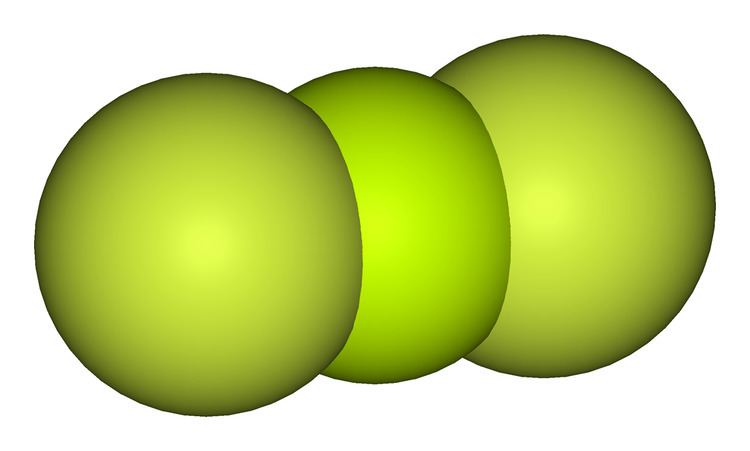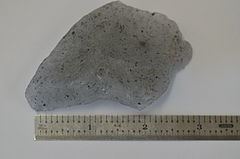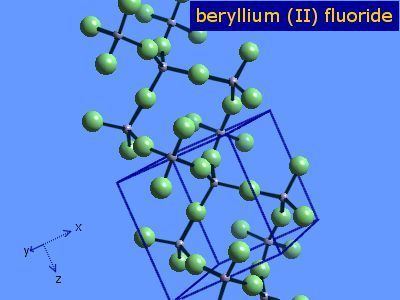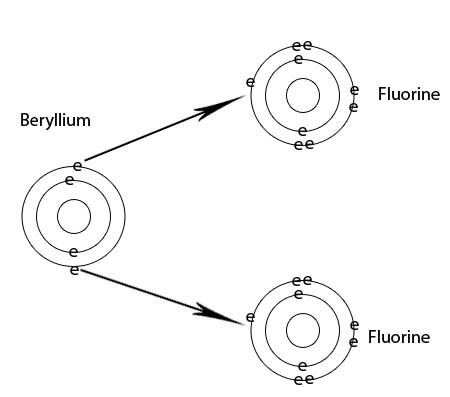Appearance colorless lumps Molar mass 47.01 g/mol Density 1.99 g/cm³ | Formula BeF2 Boiling point 1,175 °C | |
 | ||
Lewis dot structure of bef2 beryllium fluoride
Beryllium fluoride is the inorganic compound with the formula BeF2. This white solid is the principal precursor for the manufacture of beryllium metal. Its structure resembles that of quartz, but BeF2 is highly soluble in water.
Contents
- Lewis dot structure of bef2 beryllium fluoride
- Properties
- Structure and bonding
- Gaseous and liquid BeF2
- Production
- Applications
- Niche uses
- Safety
- References

Properties

Beryllium fluoride has unique optical properties. In the form of fluoroberyllate glass it has the lowest refractive index for a solid at room temperature of 1.275. It dispersive power is the lowest for a solid at 0.0093, and the non linear coefficient is also the lowest at 2 × 10−14.
Structure and bonding

The structure of solid BeF2 resembles that of cristobalite. Be2+ centers are four coordinate and tetrahedral and the fluoride centers are two-coordinate. The Be-F bond lengths are about 1.54 Å. Analogous to SiO2,BeF2 can also adopt a number of related structures. An analogy also exists between BeF2 and AlF3: both adopt extended structures at mild temperature.
Gaseous and liquid BeF2

Gaseous beryllium fluoride adopts a linear structure, with a Be-F distance of 143 pm. BeF2 reaches a vapor pressure of 10 Pa at 686 °C, 100 Pa at 767 °C, 1 kPa at 869 °C, 10 kPa at 999 °C, and 100 kPa at 1172 °C.
'Molecules' of liquid beryllium fluoride have a fluctuating tetrahedral structure. Additionally, the density of liquid BeF2 decreases near its freezing point, as Be2+ and F− ions begin to coordinate more strongly with one another, leading to the expansion of voids between formula units.
Production
The processing of beryllium ores generates impure Be(OH)2. This material reacts with ammonium bifluoride to give ammonium tetrafluoroberyllate:
Be(OH)2 + 2 (NH4)HF2 → (NH4)2BeF4 + 2 H2OTetrafluoroberyllate is a robust ion, which allows its purification by precipitation of various impurities as their hydroxides. Heating purified (NH4)2BeF4 gives the desired product:
(NH4)2BeF4 → 2 NH3 + 2 HF + BeF2In general the reactivity of BeF2 ions with fluoride are quite analogous to the reactions of SiO2 with oxides.
Applications
Reduction of BeF2 at 1300 °C with magnesium in a graphite crucible provides the most practical route to metallic beryllium:
BeF2 + Mg → Be + MgF2The chloride is not a useful precursor because of its volatility.
Niche uses
Beryllium fluoride is used in biochemistry, particularly protein crystallography as a mimic of phosphate. Thus, ADP and beryllium fluoride together tend to bind to ATP sites and inhibit protein action, making it possible to crystallise proteins in the bound state.
Beryllium fluoride forms a basic constituent of the preferred fluoride salt mixture used in liquid-fluoride nuclear reactors. Typically beryllium fluoride is mixed with lithium fluoride to form a base solvent (FLiBe), into which fluorides of uranium and thorium are introduced. Beryllium fluoride is exceptionally chemically stable and LiF/BeF2 mixtures (FLiBe) have low melting points (360 C - 459 C) and the best neutronic properties of fluoride salt combinations appropriate for reactor use. MSRE used two different mixtures in the two cooling circuits.
Safety
All beryllium compounds are highly toxic. Beryllium fluoride is very soluble in water and is thus absorbed easily; as mentioned above, it inhibits ATP uptake. The LD50 in mice is about 100 mg/kg by ingestion and 1.8 mg/kg by intravenous injection.
